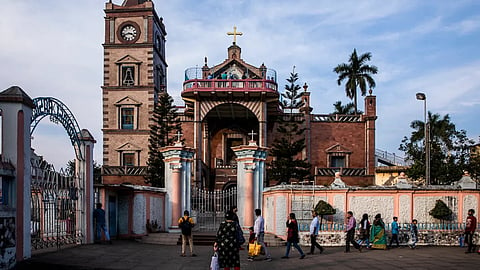
- HOMEGROWN WORLD
- #HGCREATORS
- #HGEXPLORE
- #HGVOICES
- #HGSHOP
- CAREERS
- ABOUT US
- CONTACT US

When Vasco da Gama arrived at Calicut in 1498, his arrival marked the beginning of Estado da India, or the Portuguese State of India. But unlike Portugal’s well-documented territorial ambitions on India’s western coast — primarily in Goa, Cochin, and Diu — their role in Bengal was never defined by formal colonization. Instead, Bengal experienced a different kind of Portuguese imperial project: an improvised, hybrid entanglement of piracy, private trade, missionary zeal, and localized diplomacy. The Portuguese never ruled Bengal outright, but they embedded themselves deeply into the region’s socio-political fabric — leaving behind a cultural and social legacy that still lingers in Bengal’s food, language, architecture, and culture.
By 1516, Portuguese ships reached Chittagong in the Bay of Bengal, and launched the carreira de Bengala — an annual sea route connecting Bengal with Portuguese settlements in western India. This trade was led by casados or married settlers and independent merchants who operated outside direct royal or ecclesiastical authority. These men struck strategic deals with regional rulers, offering naval expertise or weapons in exchange for trade concessions and settlement rights in the key ports of Satgaon, Hooghly, and Chittagong. Their influence was wide-ranging but informal, resembling a maritime shadow empire more than a colonial outpost.
Between the 16th and 18th centuries, this ambiguous presence resulted in conflict, collaboration, as well as cultural exchange. Portuguese harmads (Bengali for ‘pirate’, most probably derived from ‘armada’) often raided coastal towns and trafficked enslaved people across the Bay of Bengal to Cochin, and from there to Europe and South America through the Pacific Slave Trade. The word Firinghee — from the Arabic ‘Farenji’, from the Middle French word ‘Franc’ — became synonymous with foreign Christian interlopers feared for their violence, but also integrated into local power struggles during this time.
In the 1530s, for example, Sultan Mahmud Shah of Bengal sought Portuguese military help against the invasion led by Afghan warlord Sher Shah Suri. Elsewhere, in Sandwip and Arakan, Portuguese privateers declared themselves local rulers. Figures like Sebastião Gonçalves Tibau even briefly ruled over the island of Sundiva as sovereigns of their own making.
Still, the Portuguese legacy in Bengal was not only forged through conflict. Later eclipsed by the British Raj and largely forgotten, its enduring legacy lingers on in Bengal’s food, language, religion, architecture, and culture. They introduced now-essential ingredients such as potatoes, tomatoes, cashews, and chillies, which transformed Bengali cuisine.
In fact, it was Portuguese cheesemakers' experiments with local chhena (a kind of cottage cheese made from curdled milk) to produce Bandel cheese that likely laid the foundations for sweets like rosogolla and Sandesh that we now consider traditionally Bengali. Linguistically, too, the Portuguese contributed to the development and study of early-modern Bengali. In 1743, Fr Manuel da Assumpção, a Portuguese missionary, wrote ‘Vocabulario em idioma Bengalla, e Portuguez’ — the first book to codify Bengali grammar in an European language. Even today, everyday Bengali is peppered with Portuguese loanwords like almari (from armário, cupboard), sabzi (from sopa, soup) and chabi (possibly from chave, key).
Although architectural remains from the Portuguese period in Bengal are scarce, the most iconic remnant of this time is the Bandel Church, formally the Basilica of the Holy Rosary, built in the late 16th century in Bandel, Hooghly. Established after the Mughal emperor Akbar granted religious and trade freedoms to the Portuguese settlers in Bengal, it symbolized a brief golden age of syncretic, intercultural coexistence.
By the 1620s, however, Portuguese involvement in slave trafficking led to the Mughal siege of Hooghly under Shah Jahan which crushed their autonomy. Yet the Portuguese were soon allowed back — albeit under tighter scrutiny — to resume religious activities. Today, the Portuguese church in Bandel, with its baroque-inspired façades which combines both European and Bengali features, stand as a solemn reminder of the era.
Unlike the British, whose colonial empire was rigid and bureaucratic, the Portuguese operated through trade, religion, and interpersonal relationships. Intermarriage and the formation of Luso-Indian communities blurred boundaries of caste and religion, giving rise to creolized cultural zones. The descendants of these communities, many of whom converted to Christianity, contributed to Bengal’s syncretic traditions, from musical forms to poetry and even religious reformation.
One of the most compelling human embodiments of this cultural entanglement was Hensman Anthony, or Anthony Firinghee, a 19th-century poet of Portuguese descent. Fluent in Bengali and devoted to the goddess Kali, Anthony composed panchali (devotional songs) and competed in poetic duels, straddling traditions that most saw as incompatible. His story — part fact, part folklore — has inspired several films and illustrates how the descendants of Portuguese settlers negotiated their dual identities in Bengal.
Over time, the Portuguese State of India faded as the British and Dutch occupied more and more territories in India. Yet Portuguese influence in Bengal never fully disappeared. Today, their colonial legacy lingers in Bengal’s culinary traditions, language, hybrid rituals, and forgotten family lineages. As we revisit Bengal’s layered colonial history, the Portuguese chapter reminds us that empires can leave behind traces even without direct, dominant rule.
